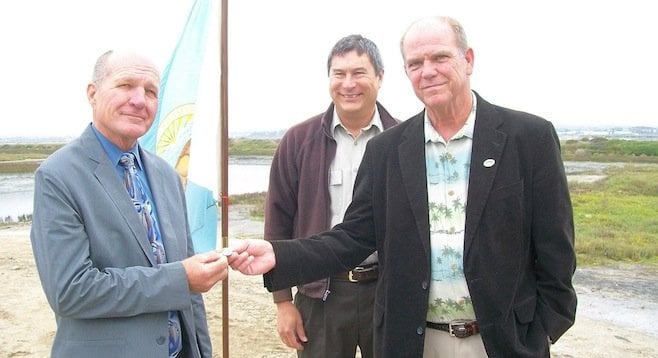 Facebook
Facebook
 X
X
 Instagram
Instagram
 TikTok
TikTok
 Youtube
Youtube

Officials gathered at the Bayshore Bikeway, where it meets Boulevard Avenue and 8th Street, in Imperial Beach on April 22 to mark the completion of the South San Diego Bay Coastal Wetland Restoration Project.
Under a cloudy sky, Imperial Beach mayor Jim Janney, San Diego National Wildlife Refuge Complex project leader Andy Yuen, and others were there to announce the release of a government report: “Restoration Returns: The Contribution of Partners for Fish and Wildlife Program and Coastal Program Projects to Local U.S. Economies.”
Using the term “ecotourism” to describe the influx of tourists he expects to impact the restored areas, San Diego County supervisor Greg Cox said, “Nature has a way to heal itself especially with the love and care given to it by U.S. Fish & Wildlife Service. The 7.7 million dollars spent is a lot of money but it created 130 jobs locally and 13.4 million dollars in economic returns. It is also helping some local businessmen who bought several old warehouses, and they will soon open Bikeway Village with a restaurant, bike shop, bike rentals. And they are also planning to open a hostel.”
According to the South San Diego Bay Coastal Wetland Restoration Project fact sheet issued by the U.S. Fish & Wildlife Service, of the 130 jobs created, 61.4% were in agriculture, 32.9% were service-related, 24.1% were in construction, 8.7% were trade, and 3.1% were listed as “other.”
The main goal of the project was to restore and enhance approximately 300 acres of coastal wetlands and uplands in San Diego Bay. Over the past 150 years, dredging and filling operations resulted in the loss of 42% of San Diego Bay's shallow subtidal habitat, 84% of its intertidal mudflat habitat, and 70% of its salt-marsh habitat. Most of the native upland habitat has been lost to development.
The $7.7 million restoration project funding was provided by the National Oceanic and Atmospheric Administration (NOAA) Restoration Center through the American Recovery and Reinvestment Act of 2009, with additional funds provided by the California Coastal Conservancy, U.S. Fish and Wildlife Service's Coastal Program, Port of San Diego, and the U.S. Environmental Protection Agency's West Coast Estuaries Initiative.
For every federal dollar that the Fish and Wildlife program partners spend on restoration, they estimate $15.70 is generated in economic returns; for every federal dollar that the coastal program spends on restoration, $12.78 is generated in economic returns.
The Bikeway Village project is reportedly being developed by Rex Butler, who bought two old warehouses at the south end of San Diego Bay, near 13th Street, several years ago.


Officials gathered at the Bayshore Bikeway, where it meets Boulevard Avenue and 8th Street, in Imperial Beach on April 22 to mark the completion of the South San Diego Bay Coastal Wetland Restoration Project.
Under a cloudy sky, Imperial Beach mayor Jim Janney, San Diego National Wildlife Refuge Complex project leader Andy Yuen, and others were there to announce the release of a government report: “Restoration Returns: The Contribution of Partners for Fish and Wildlife Program and Coastal Program Projects to Local U.S. Economies.”
Using the term “ecotourism” to describe the influx of tourists he expects to impact the restored areas, San Diego County supervisor Greg Cox said, “Nature has a way to heal itself especially with the love and care given to it by U.S. Fish & Wildlife Service. The 7.7 million dollars spent is a lot of money but it created 130 jobs locally and 13.4 million dollars in economic returns. It is also helping some local businessmen who bought several old warehouses, and they will soon open Bikeway Village with a restaurant, bike shop, bike rentals. And they are also planning to open a hostel.”
According to the South San Diego Bay Coastal Wetland Restoration Project fact sheet issued by the U.S. Fish & Wildlife Service, of the 130 jobs created, 61.4% were in agriculture, 32.9% were service-related, 24.1% were in construction, 8.7% were trade, and 3.1% were listed as “other.”
The main goal of the project was to restore and enhance approximately 300 acres of coastal wetlands and uplands in San Diego Bay. Over the past 150 years, dredging and filling operations resulted in the loss of 42% of San Diego Bay's shallow subtidal habitat, 84% of its intertidal mudflat habitat, and 70% of its salt-marsh habitat. Most of the native upland habitat has been lost to development.
The $7.7 million restoration project funding was provided by the National Oceanic and Atmospheric Administration (NOAA) Restoration Center through the American Recovery and Reinvestment Act of 2009, with additional funds provided by the California Coastal Conservancy, U.S. Fish and Wildlife Service's Coastal Program, Port of San Diego, and the U.S. Environmental Protection Agency's West Coast Estuaries Initiative.
For every federal dollar that the Fish and Wildlife program partners spend on restoration, they estimate $15.70 is generated in economic returns; for every federal dollar that the coastal program spends on restoration, $12.78 is generated in economic returns.
The Bikeway Village project is reportedly being developed by Rex Butler, who bought two old warehouses at the south end of San Diego Bay, near 13th Street, several years ago.
Comments